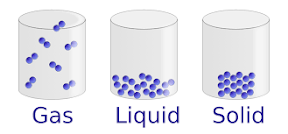Class 9 Chemistry L1 States Of Matter
[reference: Class 9, Chemistry, S Chand Pubication]
1. Define the following:
a. Matterb. Mass
c. Volume
d. Diffusion
e. Brownian movement
f. Melting
g. Fusion
h. Condensation
i. Freezing
j. Solidification
k. Boiling
l. Melting Point
m. Boiling Point
n. Freezing Point
o. Latent heat
p. Latent heat of fusion
q. Latent heat of vaporisation
r. Sublimation
s. Perspiration
2. What does diffusion tell us about the nature of particles of matter?
3. Fill in the blanks:
a. _____________ gave the best evidence for the existence and movement of particles in liquid in the year ________. (Robert Brown, 1827)
b. Melting point of ice is _________ and boiling point of water is _____ on Celsius scale.
c. The SI unit of measuring temperature is ________.
d. Melting point of ice is _________ and boiling point of water is _____ on Kelvin scale.
e. 0o C = _____ K
f. Temperature on Kelvin scale = ________________ +273
g. 25o C = _____ K
h. 300 K = ____o C
i. Matter exists in three physical states: __________, __________ and __________.
j. Dry ice sublimes to form _____________.
4. Give reasons:
a. When sugar is added to water and stirred, it dissolves quickly
b. There is no change in volume of water, when sugar is dissolved in it
c. The fragrance of the burning incense stick spreads in the entire room very quickly.
d. When a few crystals of blue copper sulphate crystals are placed at the bottom of a beaker containing water, then water in the whole beaker turns blue slowly.
e. Solids, liquids and gases have different properties.
f. A rubber changes its shape on stretching, yet we call it a solid.
g. When salt is put in jars of different shapes, it takes the shape of the jar. Yet we call it a solid.
h. A sponge can be compressed easily, yet we call it a solid.
i. Gases are compressed easily, but not solids.
j. The rate of diffusion in liquids is much faster than that in solids,
k. The diffusion of a solid substance into another solid substance is very slow.
l. The rate of diffusion increases on increasing the temperature of the diffusing substance by heating.
m. Light gases diffuse faster than the heavy gases.
n. Temperature of melting ice does not rise even though heat is supplied continuously.
o. Latent heat does not cause a rise in temperature of the substance.
p. Ice at 0O C is more effective in cooling than water at 0o C
q. Temperature of boiling water does not rise even though heat is being given continuously.
r. Steam (100o C) causes more severe burning than boiling water (100o C)
s. Naphthalene balls disappear with time leaving behind no residue.
t. Dry ice can produce much lower temperature than ordinary ice.
u. Dry ice is stored under high pressure.
v. Dry ice is used to deep freeze food and keep ice cream cold.
w. We should wear cotton clothes in summer.
x. We feel cool under a running fan.
y. A desert cooler cools better on a hot and dry day.
z. We are able to sip hot tea faster from a saucer than from a cup.
aa. Evaporation causes cooling.
bb. If we put spirit at the back of our hand and and wave it around, our hand feels cold.
cc. Water is kept in earthen pot during summer.
dd. People often sprinkle water on the ground in front of their homes during summer evenings.
ee. We feel cool under a tree during hot summers.
ff. Honey is more viscous than water.
gg. Air is used to inflate tyres.
hh. Steel is used to make railway lines.
5. List the characteristic features of the particles of matter.
6. List the two ways by which, we can change the physical states of matter.
7. List the factors affecting evaporation. Also, state how these factors affect evaporation.
8. Name some substances that undergo sublimation.
9. Differentiate between
a. Rigid and fluid
b. Solid, liquid and gas
c. Evaporation and vaporisation
d. Vapour and gas
10. Name these:
a. A rigid form of matter
b. A fluid form of matter
11. Give the full forms of :
a. LPG
b. CNG

Comments